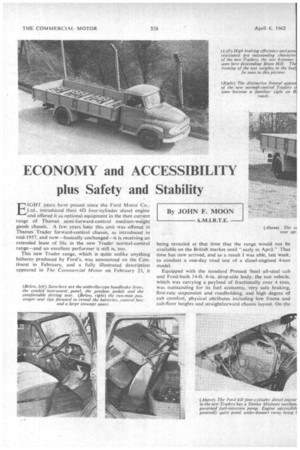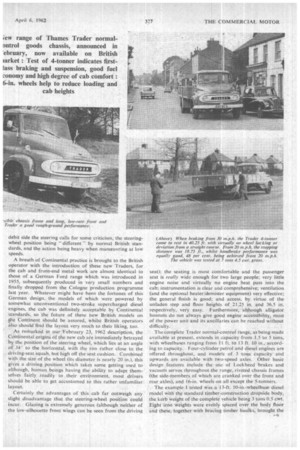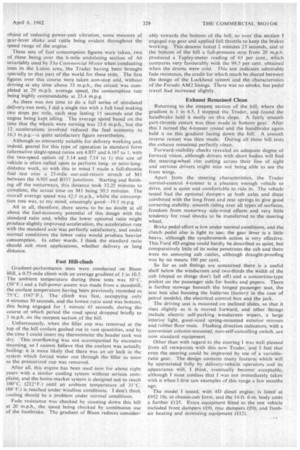ECONOMY and ACCESSIBILITY plus Safety and Stability
Page 74

Page 75

Page 76

Page 79

If you've noticed an error in this article please click here to report it so we can fix it.
EIGHT years have passed since the Ford Motor' Co.. Ltd., introduced their 4D four:cylinder diesel engine and offered it as optional equipment in the then current range of Thames semi-forward-control medium-weight goods chassis. A few years later this unit was offered in Thames Trader forward-control chassis, as introduced in mid-1957, and now—basically unchanged—it is receiving an extended lease of life in the new Trader normal-control range—and an excellent performer it still is. too.
This new Trader range, which is quite unlike anything hitherto produced by Ford's, was announced on the Continent in February, and a fully illustrated description appeared in The Commercial Motor on February 23, it being revealed at that time that the range would not be available on the British market until" early in April.That Lime has now arrived, and as a result I was able, last week, to conduct a one-day road test of a diesel-engined 4-ton model.
Equipped with the standard Pressed Steel all-steel cab and Ford-built 14-ft. 6-in, drop-side body, the test vehicle, which was carrying a payload of fractionally over 4 tons, was outstanding for its fuel economy, very safe braking, first-rate suspensibn and roadholding, and high degree of cab comfort, physical attributes including low frame and cab-floor heights and straightforward chassis layout. On the debit side the steering calls for some criticism, the steeringwheel position being different" by normal British standards, and the action being heavy when rnanceuvring at low speeds.
A breath. of Continental practice is brought to the British operator with the introduction of these new Traders, for the cab and front-end metal work are almost identical to those of a German Ford range which was introduced in 1955, subsequently produced in very small numbers and finally dropped from the Cologne production programme last year. Whatever might have been the fortunes of this German design, the models of which were powered by somewhat unconventional two-stroke supercharged diesel engines, the cab was definitely acceptable by Continental standards, so the future of these new British models on he Continent should be assured, whilst British operators also should find the layout very much to their liking, too.
As remarked in our 'February 23, 1962 description, the Continental origins of the new cab are immediately betrayed by the position of the steering wheel, which lies at an angle of 34 to the horizontal, with the rim rather close to the driving-seat squab. but high off the seat cushion. Combined With the size of the wheel (its diameter is nearly 20 in.). this gives a driving position which takes some getting used to although, human beings having the ability to adapt themselves fairly readily to their environment, most drivers should be able to get accustomed to this rather unfamiliar layout.
Certainly the advantages of this cab far outweigh any slight disadvantage that the steering-wheel position could incur. Glazing is extremely generous (although neither of the low-silhouette front wings can be seen from the driving
seat); the seating is most comfortable and the passenger seat is really wide enough for two large people; very little engine noise and virtually no engine heat pass into the cab; instrumentation is clear and comprehensive; ventilation (and the optional heater/demister equipment) very effective; the general finish is good; and access, by virtue of theunladen step and floor heights of 21.25 in. and 36.5 in. respectively, very easy. Furthermore, although alligator bonnets do not always give good engine accessibility„ most of the power unit and its ancillaries can be reached without difficulty.
The complete Trader normal-control range, as being made available at present, extends in capacity from 1.5 to 5 tons, with wheelbases ranging from 11 ft. to 13 ft. 10 in., according to capacity. Four-cylinder petrol and diesel engines are offered throughout, and models of 3 -tons capacity and upwards are available with two-speed axles. Other basic design features include the use of Lockheed brakes and vacuum servos throughout the range, riveted chassis frames (the side-members of which are cranked over the front and rear axles), and 16-in, wheels on all 'except the 5-tonners.
• The example I tested was a 13-ft 10-in.-wheelbase diesel Model with the standard timber construction dropside body, the kerb weight of the complete vehicle being 3 tons 0.5 cwt. Eight iron weights were evenly spaced Over the body floor and these, together with bracing timber baulks, brought the gross weight of the vehicle up to 7 tons I cwt., the addition of Ford's Roy Aston, myself and various items of test equipment increasing this by a further 3,5 cwt. The interaxle weight distribution was of the order of 27.5: 72.5close to Ford's recommended ratio of 30 : 70.
The imposed load added only 8.75 cwt. to the front-axle loading in kerb condition, by far the greater amount of the payload being borne by the rear wheels. This tended to give the Trader a tail-heavy appearance, whilst the low front-axle loading should have given light steering, although this was not the case. The test vehicle was shod with Goodyear 7.50-16 Unisteet braced-tread tyres, optional to which are Michelin " X " tyres of the same size. Ford's have found it expedient with this 16-in, equipment to balance the front wheels, so all production models (like the test vehicle) have balanced front and spare wheels.
My tests got off to a good start in that braking figures were checked first and these were of a very high order indeed._ Full-pressure stops were made with the footbrake from 20 and 30 m.p.h.. and while coming to rest from the lower speed no wheel locking at all occurred, whilst the Tapley meter indicated an average maximum retardation rate of 99.5 per cent. When braking. from 30 m.p.h. very slight locking was observed at the off-side rear, the distance involved being only about 1 ft., whilst the Tapley meter readings averaged 92.5 per cent.
This sort of braking performance is what most manufacturers strive to obtain but very few manage to reach, and in this respect the Trader normal-control 4-tonner is ol quite the safest vehicle of its weight that I can recall having handled. At all times the retardation was smooth, with no evidence of system lag, and the absence of serious wheel locking indicates both good system balance and safety on slippery road surfaces. It must be admitted in this respect that the braced-tread tyres would be of some assistance, these having a higher resistance to skidding than conventional textile tyres.
The Trader's handbrake lever is of the umbrella type, located close to the steering column and having a maximum travel of 33 notches. Tapley-meter stops from 20 m.p.h. with this brake produced consistent readings of 48 per cent. -again showing exceptional braking efficiency-although the lever came out rather a long way, about two-thirds of the available travel being used.
The acceleration tests showed the Trader to be surprisingly lively. On the standing-start runs all four gearbox ratios were used, changes being made at approximately the maximum speeds in each gear-5 m.p.h., first; 15 m.p.h., second; and 29 m.p.h. third, top-gear speed being 47 mp.h. with the standard 5.286-to-1 axle fitted. I was very pleased with the acceleration rate up to 30 m.p.h., and surprised also at the short time taken to reach the same speed when accelerating in direct drive' from 10 m.p.h.
Admittedly, the engine behaved rather roughly during this latter test up to about 14 m.p.h., and violent gear-lever vibration was prevalent too, but this sort of thing is rarely avoidable with a four-cylinder diesel. In any case, enginemounting development ,work is still in progress with the object of reducing power-unit vibration, some measure of gear-lever shake and rattle being evident throughout the speed range of the engine.
Three sets of fuel consumption figures were taken, two of these being over the 6-mile undulating section of Ab invariably used by The Commercial Motor when conducting tests in the Luton area, the Trader having been brought specially to that part of the world for these tests, The first figures over this course were taken non-stop and, without driving at any time above 33 m.p.h., the circuit was completed at 29 m.p.h. average speed, the consumption rate being highly commendable at 23.4 m.p.g.
As there was not time to do a full series of simulated delivery-run tests, I did a single run with a full load making two stops per mile, each stop lasting 15 seconds and the engine being kept idling. The average speed based on the time that the wheels were turning was 23.6 m.p.h., but the 12 accelerations involved reduced the fuel economy to 16.3 m.p.g.—a quite satisfactory figure nevertheless.
Although so eminently suitable for delivery working and. indeed, geared for this type of operation in standard form (alternative single-speed ratios are 4.857 and 6.167 to I, with the two-speed option of 5.14 and 7.14 to 1) this size of vehicle is often called upon to perform longor semi-longdistance work, so with this in mind I made a full-throttle fuel test over a 23-mile out-and-return stretch of MI between the A505 and B557 junctions. Starting and finishing off the motorways, this distance took 32.25 minutes to complete, the actual time on MI being 30.5 minutes. The overall average speed was 42.5 m.p.h., whilst the consumption rate was, to my mind, amazingly good-19.1 m.p.g.
All in all, therefore, there seems to be no doubt at all about the fuel-economy potential of this design with the standard ratio and, whilst the lower optional ratio might produce slightly improved acceleration, the acceleration rate with the standard axle was perfectly satisfactory, and under normal conditions the lower ratio would produce heavier consumption. In other Words, I think the standard ratio should suit most applications, whether delivery or long distance.
Fast Hill-climb
Gradient-performance tests were conducted on Bison Hill, a 0.75-mile climb with an average gradient of I in 10.5. The ambient temperature during these tests was 10°C. (50°F.) and a full-power ascent was made from a standstill, the coolant temperature having been previously recorded as 75°C. (167°F.). The climb was fast, occupying only 4 minutes 30 seconds, and the lowest ratio used was bottom, this being engaged for 1 minute 45 seconds, during the course of which period the road speed dropped briefly to 5 m.p.h. on the steepest section of the hill.
Unfortunately, when the filler cap was removed at the top of the hill coolant gushed out in vast quantities, and by the time I could insert my thermometer the header tank was dry. This overflowing was not accompanied by excessive steaming, so I cannot believe that the coolant was actually .boiling: it is more likely that there was an air lock in the system which forced water out through the filler as soon as the pressurized cap was removed.
After all, this engine has been used now for about eight years with a similar cooling system without serious complaint, and the home-market system is designed not to reach 100°C. (212°F.) until an ambient temperature of 31'C. (88°F.) is reached under windless conditions. I don't think cooling should be a problem under normal conditions.
Fade resistance was checked by coasting down this hill at 20 m.p.h., the speed being checked by continuous use of the footbrake. The gradient of Bison reduces consider
ably towards the bottom of the hill, so over this section 1 engaged top gear and applied full throttle to keep the brakes working. This descent lasted 2 minutes 23 seconds, and at the bottom of the hill a full-pressure stop from 20 rn,p.h. produced a Tapley-meter reading of 65 per cent., which compares very favourably with the 99.5 per cent, obtained when the drums were cold. This test indicates admirable fade resistance, the credit for which much be shared between the design of the Lockheed system and the characteristics of the Ferodo AM2 linings. There was no smoke, but pedal travel had increased slightly.
Exhaust Remained Clean
Returning to the steepest section of the hill, where the gradient is 1 in 6.5, I stopped the Trader, and found the handbrake held it easily on this slope. A fairly smooth part-throttle restart was then made in bottom gear. After this I turned the 4-tonner round and the handbrake again held it on this gradient facing down the hill. A smooth reverse restart was then made. During all these hill tests the exhaust remained perfectly clean.
Forward-visibility checks revealed an adequate degree of forward vision, although drivers with short bodies will find the steering-wheel rim cutting across their line of sight and nervous drivers might miss not being able to see the front wings.
Apart from the steering characteristics, the Trader normal-control 4-tonner is a pleasant enough vehicle to drive, and is quiet and comfortable to ride in. The vehicle tested had the optional dampers at both axles and these combined with the long front and rear springs to give good cornering stability, smooth riding over all types of surfaces, freedom from motorway side-wind effects and very little tendency for road shocks to be transferred to the steering wheel.
Brake pedal effort is low under normal conditions, and the clutch pedal also is light to use; the gear lever is a little heavy, although the synchromesh action is very effective. This Ford 4D engine could hardly be described as quiet, but comparatively little of its noise penetrates the cab and there were no annoying cab rattles, although draught-proofing was by no means 100 per cent.
So far as cab fittings are concerned there is a useful shelf below the windscreen and two-thirds the width of the cab (sloped so things don't fall off) and a concertina-type poacet on the passenger side for books and papers. There is further stowage beneath the hinged passenger seat, the seat box also housing the batteries (battery in the case of petrol models), the electrical control box and the jack.
The driving seat is mounted on inclined slides, so that it rises slightly as it is moved forward, and other fittings include electric self-parking windscreen wipers, a large interior light, good-sized spring-mounted exterior mirrors and rubber floor mats. Flashing direction indicators, with a convenient column-mounted, non-self-cancelling switch, are now standard equipment.
Other than with regard to the steering I was well pleased from all viewpoints with this new Trader, and I feel that even the steering could be improved by use of a variableratio gear. The design contains many features which will be appreciated fully by delivery-vehicle operators and its appearance will, I think, eventually become acceptable, although I must confess that I was not immediately taken with it when I first saw examples of this range a few months ago.
The model I tested, with 413 diesel engine, is listed at £952 10s. in chassis-cab form, and the I4-ft. 6-in, body costs a further f125. Extra equipment fitted to the test vehicle included front dampers (0), rear dampers (9), and freshair heating and demisting equipment (£12).




















































































































































